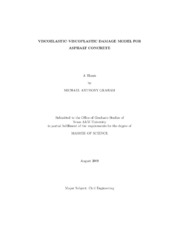| dc.description.abstract | This thesis presents a continuum model for asphalt concrete incorporating non-
linear viscoelasticity, viscoplasticity, mechanically-induced damage and moisture-
induced damage. The Schapery single-integral viscoelastic model describes the
nonlinear viscoelastic response. The viscoplastic model of Perzyna models the time-
dependent permanent deformations, using a Drucker-Prager yield surface which is
modified to depend on the third deviatoric stress invariant to include more complex
dependence on state of stress. Mechanically-induced damage is modeled using continuum damage mechanics, using the same modified Drucker-Prager law to determine
damage onset and growth. A novel moisture damage model is proposed, modeling
moisture-induced damage using continuum damage mechanics; adhesive moisture-
induced damage to the asphalt mastic-aggregate bond and moisture-induced cohesive
damage to the asphalt mastic itself are treated separately.
The analytical model is implemented numerically for three-dimensional and plane
strain finite element analyses, and a series of simulations is presented to show the
performance of the model and its implementation. Sensitivity studies are conducted
for all model parameters and results due to various simulations corresponding to
laboratory tests are presented.
In addition to the continuum model, results are presented for a micromechanical
model using the nonlinear-viscoelastic-viscoplastic-damage model for asphalt mastic and a linear elastic model for aggregates. Initial results are encouraging, showing the
strength and stiffness of the mix as well as the failure mode varying with moisture
loading. These initial results are provided as a an example of the model's robustness
and suitability for modeling asphalt concrete at the mix scale. | en |


